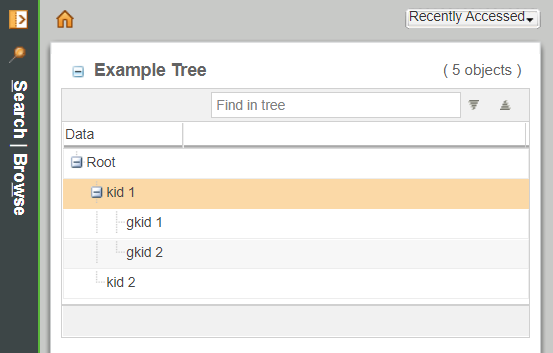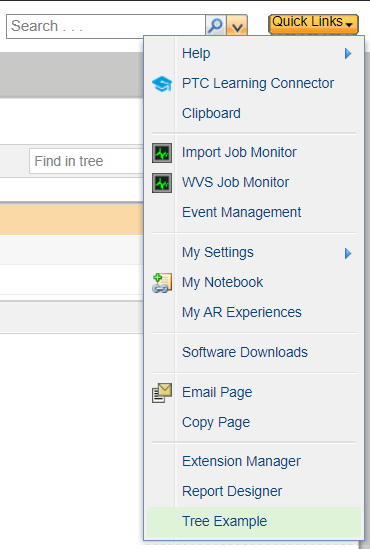Example 10: Tree
If you can't play the video, make sure that you are logged in at Wex Solutions.
- What will we do? - Learn the basics of trees
-
What do you need? - Site access to a non-production Windchill
-
How long will it take - 5 minutes
This example showcases how to implement Tree-based entities in the Windchill UI.
You can find the code for the example in our GitHub repository.
Implementation
This example adds a standard JCA Windchill Tree with a Data Utility. The result looks like this:

The implementation consists of the following classes:
| Class | Extends | Annotation | Description |
|---|---|---|---|
| WexTreeBuilder | AbstractConfigurableTableBuilder | WexBean, WexComponent, ComponentBuilder | This is the builder that constructs the table. It must be annotated so that it becomes visible as a Feature outside the extension. |
| WexTreeRow | NmObject | The is a POJO that is interrogated by reflection to create a row. The NmObject gives the table row a unique id | |
| WexExampleTreeHandler | TreeHandlerAdapter | The data provider that will populate the tree | |
| ExampleDataUtil | AbstractDataUtility | WexDataUtility | The code that populates a cell in the tree. Can be text of a graphical element such as an Icon |
The WexTreeBuilder implementation has a ComponentBuilder annotation:
@WexBean("com.wincomplm.wex-example-tree.wextree")
@WexComponent(uid = "com.wincomplm.wex-example-tree.wextree", description = "Wex Example Tree")
@ComponentBuilder("com.wincomplm.wex-example-tree.wextree")
public class WexTreeBuilder extends AbstractConfigurableTableBuilder {
The Builder is implemented as follows:
@Override
public ComponentConfig buildComponentConfig(ComponentParams cp) throws WTException {
logger.trace("=>buildComponentConfig {0}", cp);
ComponentConfigFactory factory = getComponentConfigFactory();
TreeConfig tree = factory.newTreeConfig();
tree.setLabel("Example Tree");
ColumnConfig col = factory.newColumnConfig("wex-example-tree-data", true);
col.setLabel("Data");
tree.addComponent(col);
tree.setFindInTableMode(FindInTableMode.CLIENT_ONLY);
((JcaTreeConfig) tree).setExpansionLevel(TableTreeProperties.ONE_EXPAND);
tree.setShowTreeLines(true);
tree.setShowCustomViewLink(false);
logger.trace("<=buildComponentConfig");
return tree;
}//buildComponentConfig
@Override
public Object buildComponentData(ComponentConfig cc, ComponentParams cp) throws Exception {
logger.trace("=>buildComponentData {0} {1}", cc, cp);
WexExampleTreeHandler handler = WexExampleTreeHandler.newWexExampleTreeHandler();
logger.trace("<=buildComponentData");
return handler;
}//buildComponentData
This class uses wex-example-tree-data ID for the data utility, implemented by the class:
@WexDataUtility("wex-example-tree-data")
@WexComponent(uid = "wex-example-tree-data", description = "Data")
public class ExampleDataUtil extends AbstractDataUtility {
@Override
public Object getDataValue(String string, Object o, ModelContext mc) throws WTException {
if (!(o instanceof WexTreeRow)) {
return null;
}
return ((WexTreeRow) o).getData();
}
}
Like we saw in the Table example, the WexTreeRow implementation has a POJO with getters:
public String getData()
As a table requires a unique ID for each element, the row must implement NmObject and this will be returned in the Component Builder. These methods can also return objects that inherit from com.ptc.core.components.rendering.guicomponents.HTMLGuiComponent
Execution
Access the new entry in the Quick Links menu:

The Tree will appear as follows:
